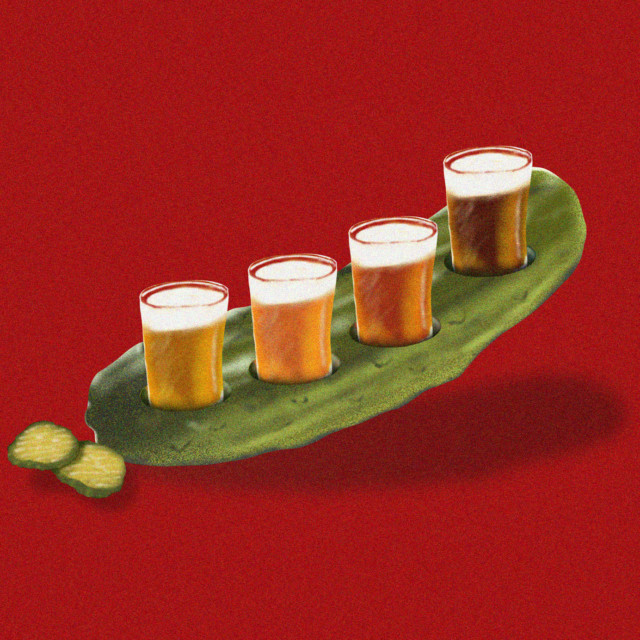This October, VinePair is celebrating our second annual American Beer Month. From beer style basics to unexpected trends (pickle beer, anyone?), to historical deep dives and new developments in package design, expect an exploration of all that’s happening in breweries and taprooms across the United States all month long.
Home to Heinz and historical waves of Eastern European immigrants, it’s no surprise that Pittsburgh loves its pickles. The city celebrates its briny heritage each summer with Picklesburgh, where attendees can sample pickle-flavored ice cream, pickle Palomas, and chocolate-covered pickles on a stick.
“Any absurd pickle thing you can think of, you put a pickle on it,” says Scott Smith, the founder of East End Brewing. Beer, too: In 2019, East End teamed up with Pittsburgh-born sandwich chain Primanti Brothers to create the Almost Famous Pickle Beer packed with dill, coriander, and 600 pounds of cucumbers. (The chain calls its fry-filled sandwiches “almost famous.”)
Timed for release around Picklesburgh, Almost Famous Pickle Beer soon sold out and spawned an annual tradition. This year, East End produced 40 barrels of pickle beer, requiring some 1,600 pounds of hand-peeled, chopped, and juiced cucumbers. “Your hands actually get a dark green color when you peel cucumbers all day,” Smith says. East End released the batch at the end of August, and it sold out within several days. “It’s kind of bonkers.”
For American breweries, it’s a pretty good time to be in a pickle. They’re finding success across the country producing sour ales packed with pickle brine, cucumbers, herbs and the same spices submerged in a Vlasic jar.
In 2020, New Braunfels Brewing, located outside San Antonio, saw its mixed-fermentation PKL FKR and variants account for north of 85 percent of sales. “It was high enough that I didn’t bother figuring out” the exact number, says head brewer Kelly Meyer.
Pickle-beer partnerships are rooted less in gimmickry than flavorful symmetry. Lactic fermentation turns cucumbers tart, and herbs, spices, and salt contribute flavor. On the beer side, brewers regularly add Lactobacillus bacteria to wheat ales to create a gose, a German-style sour ale seasoned with salt and coriander.
A straight gose can be a tough sell, the tangy acidity a little foreign to domestic beer drinkers. But a flavor profile can become recognizable when adding fruits or vegetables, a fact held true by Urban Artifact. “People gravitate to tart and sour beers when they have familiar flavors,” says Scotty Hunter, the chief of strategic development.
The Cincinnati brewery specializes in fruited sour ales and one very vegetal seasonal. In 2016, the brewery team batted around ideas for holiday beers, and Hunter offered the (purported) German tradition of hiding a pickle in a Christmas tree.
Urban Artifact took its base sour ale and added sea salt, cucumbers, dill, and coriander, creating a holiday lark that “turned out to taste really, really good,” Hunter says. “It definitely became more of a monster than we expected,” he says of the annual holiday specialty now called Xmas Pickle.
Down in Texas, pickle beers are a year-round staple. In 2015, New Braunfels was among the first breweries to offer a mash-up, though PKL FKR received a prickly initial response. “Back then it was like, ‘You’re an idiot. Why’d you make that?’” Meyer recalls.
Meyer made PKL FKR with wheat, a mixed culture of native yeast and bacteria, and leftover pickle juice sourced from a local Wingstop. By 2019 or so, the pickle beer’s growing popularity meant that Meyer needed more brine. A friend tipped him off to Texas Tito’s, a local pickle company, and Meyer now sources 275-gallon totes brimming with brine.
Martin House Brewing in Fort Worth has a direct supply line to pickle juice. It works with the nearby Best Maid Pickles, a Texas stalwart since 1926, on its Best Maid Sour Pickle Beer. “Once a week, sometimes twice, they’ll pull on their big Best Maid 18-wheeler with a bunch of totes on it full of pickle brine,” says Sam “Shugg” Cole, Martin House’s brand manager.
Several years ago, the companies began collaborating for the brewery’s Sour Fest. Best Maid brought pickles, and Martin House served a gose spiked with pickle juice. In 2019, Martin House canned Best Maid Sour Pickle Beer — the label incorporates Best Maid’s cartoon character Smiley — and dropped it into distribution. “It was just another beer that was going to be here for a week and gone forever,” Cole says, recalling no big sales hopes. “It turned into a phenomenon.”
Pickle beers now account for more than 30 percent of the brewery’s sales, including variants such as Spicy Pickle Beer, Bloody Mary Pickle Beer, and a Grape Punch Pickle Beer. It’s inspired by the Texas tradition of making pickles with sugar and Kool-Aid, a.k.a. the Koolicle.
“I thought it would be pretty popular, but then it just kind of took over the internet,” Cole says of the beer, released in August. “What was I doing for two weeks? I was telling people across America and the world, ‘No, I can’t ship you this beer.’”
Smith of East End plans to keep his pickle beer as an annual one-off, the condiment beer a complement to regular releases. Making another collaborative beer with Primanti’s is possible, but topping pickles might be tough. “We’re like, what can we do next? Could we do a French fry?” Smith says, laughing. “No, we’re not doing French fry beer.”
